
Wagonways, also known as horse-drawn railways and horse-drawn railroad consisted of the horses, equipment and tracks used for hauling wagons, which preceded steam-powered railways. The terms plateway, tramway, dramway, were used. The advantage of wagonways was that far bigger loads could be transported with the same power.

A wagon or waggon is a heavy four-wheeled vehicle pulled by draught animals or on occasion by humans, used for transporting goods, commodities, agricultural materials, supplies and sometimes people.

In US railroad terminology, a gondola is an open-topped rail vehicle used for transporting loose bulk materials. Because of their low side walls, gondolas are also suitable for the carriage of such high-density cargos as steel plates or coils, or of bulky items such as prefabricated sections of rail track. Gondolas are distinct from hopper cars in that they do not have doors on their floor to empty cargo.
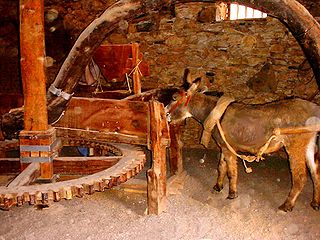
A horse mill is a mill, sometimes used in conjunction with a watermill or windmill, that uses a horse engine as the power source. Any milling process can be powered in this way, but the most frequent use of animal power in horse mills was for grinding grain and pumping water. Other animal engines for powering mills are powered by dogs, donkeys, oxen or camels. Treadwheels are engines powered by humans.

Strelley is a village and civil parish in the Borough of Broxtowe and City of Nottingham in Nottinghamshire, England. It is to the west of Nottingham. The population of the civil parish taken at the 2011 census was 653. It is also the name of the nearby post war council housing estate. The village lies within the Broxtowe district, whilst the estate is in the City of Nottingham. The village is separated from the housing estate by the A6002 road.
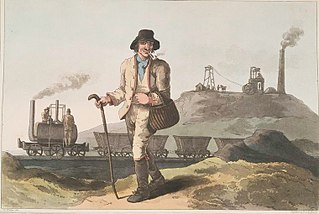
A chaldron was an English measure of dry volume, mostly used for coal; the word itself is an obsolete spelling of cauldron. It was used from the 13th century onwards, nominally until 1963, when it was abolished by the Weights and Measures Act 1963, but in practice until the end of 1835, when the Weights and Measures Act of that year specified that thenceforth coal could only be sold by weight.

In Irish and British civil engineering, a banksman is the person who directs the operation of a crane or larger vehicle from the point near where loads are attached and detached. The term 'dogman' may be used in Australia and New Zealand, while 'spotter' is the more common term in United States.

A hurrier, also sometimes called a coal drawer or coal thruster, was a child or woman employed by a collier to transport the coal that they had mined. Women would normally get the children to help them because of the difficulty of carrying the coal. Common particularly in the early 19th century, the hurrier pulled a corf full of coal along roadways as small as 0.4 metres (16 in) in height. They would often work 12-hour shifts, making several runs down to the coal face and back to the surface again.
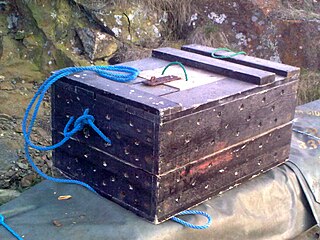
A corf also spelt corve is a container of wood, net, chicken wire, metal or plastic used to contain live fish, eels or crustaceans underwater, at docks or in fishing boats.
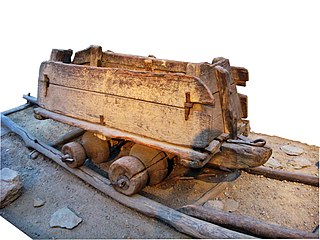
A minecart or mine cart is a type of rolling stock found on a mine railway, used for moving ore and materials procured in the process of traditional mining. Minecarts are seldom used in modern operations, having largely been superseded in underground operations by more efficient belt conveyor systems that allow machines such as longwall shearers and continuous miners to operate at their full capacity, and above ground by large dumpers.
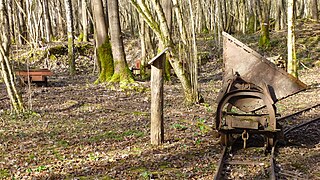
A tub or quarry tub is a type of railway or tramway wagon used in quarries and other industrial locations for the transport of minerals from a quarry or mine face to processing plants or between various parts of an industrial site. This type of wagon may be small enough for one person to push, or designed for haulage by a horse, or for connection in a train hauled by a locomotive. The tubs are designed for ease of emptying, usually by a side-tipping action. This type of rail vehicle is now mainly obsolete, its function having been mostly replaced by conveyor belts.

Chatterley Whitfield Colliery is a disused coal mine on the outskirts of Chell, Staffordshire in Stoke on Trent, England. It was the largest mine working the North Staffordshire Coalfield and was the first colliery in the UK to produce one million tons of saleable coal in a year.

A mine railway, sometimes pit railway, is a railway constructed to carry materials and workers in and out of a mine. Materials transported typically include ore, coal and overburden. It is little remembered, but the mix of heavy and bulky materials which had to be hauled into and out of mines gave rise to the first several generations of railways, at first made of wooden rails, but eventually adding protective iron, steam locomotion by fixed engines and the earliest commercial steam locomotives, all in and around the works around mines.
John Curr was the manager or viewer of the Duke of Norfolk's collieries in Sheffield, England from 1781 to 1801. During this time he made a number of innovations that contributed significantly to the development of the coal mining industry and railways.
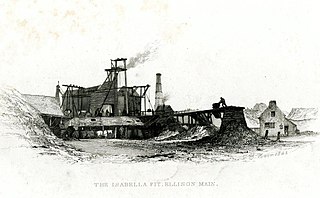
Sheriff Hill Colliery or Ellison Main Colliery was a coal mine at Gateshead Fell in County Durham, England. The colliery had two shafts and provided employment to the residents of Sheriff Hill, after it opened in 1793. There were many major accidents resulting in the deaths of workers at the colliery. There was a protracted strike at the colliery in 1834. The colliery closed in 1926.
A corf is an underwater container used to hold live fish or crustaceans.
Matthew Tate was a Newcastle born poet and songwriter, who spent much of his adult life living in Blyth.
This is a partial glossary of coal mining terminology commonly used in the coalfields of the United Kingdom. Some words were in use throughout the coalfields, some are historic and some are local to the different British coalfields.
















